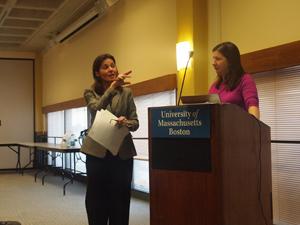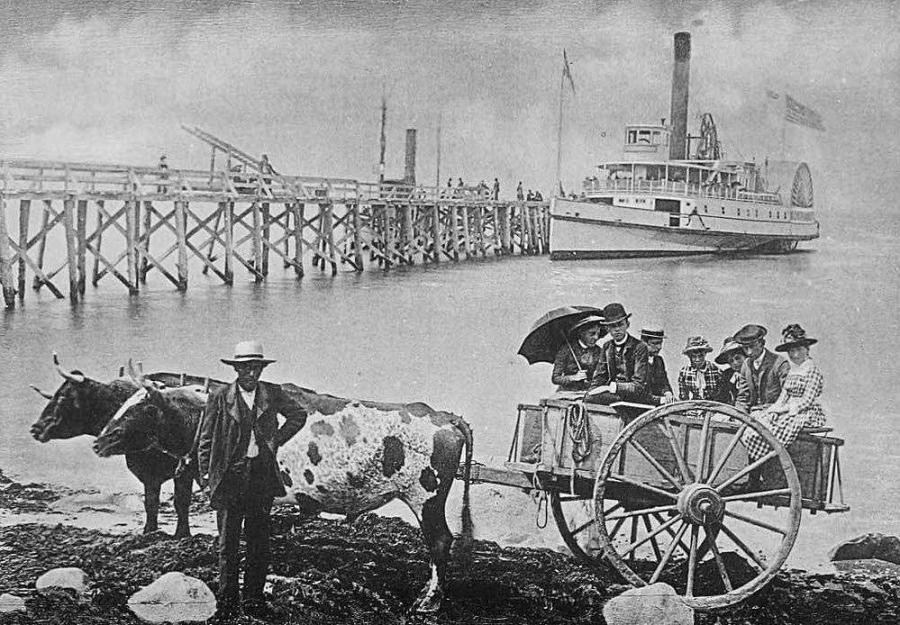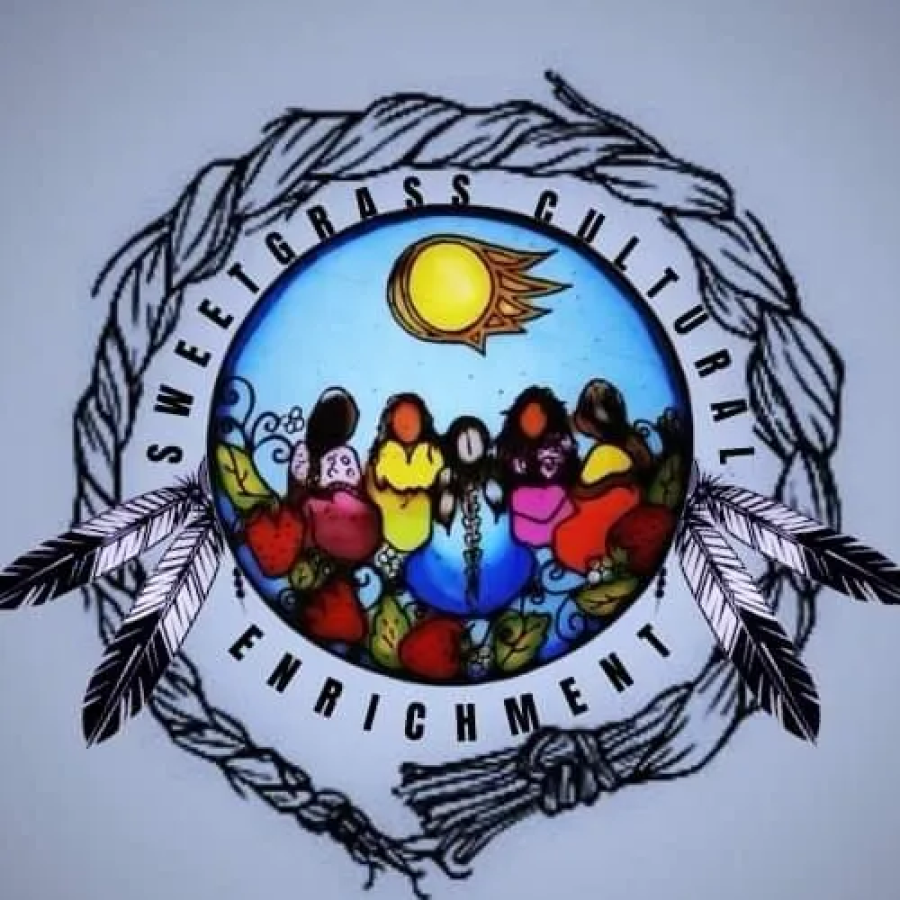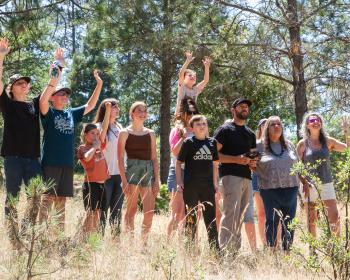
By Matthew Chuckran
Many have questioned whether or not human rights mechanisms are useful tools in settling Indigenous Peoples’ claims. On February 23, 2012, Cultural Survival board member Nicole Friederichs and fellow Suffolk University Law professor Lorie M. Graham presented a lecture sponsored by the University of Massachusetts Boston's anthropology department entitled “Resolving Indigenous Claims through Human Rights Mechanisms.” The lecture provided a twofold analysis of Indigenous claim resolutions, discussing the various legal and organizational apparatuses Indigenous groups may access to mediate or resolve claims, and detailing both the advantages and shortcomings in applying these mechanisms.
Many of the legal avenues available to Indigenous people today can be traced to the United Nation’s Universal Declaration of Human Rights (UDHR) adopted in 1948, which, while not being a legally binding document, set international standards for human rights entitlements. With its adoption, a recognized precedent was set that provided a tangible and a universal definition of human rights. The Declaration has served as the lifeblood as well as a point of reference for rights violations.
Along with a host of other human rights declarations and treaties, the United Nation’s Declaration on the Rights of Indigenous Peoples (UNDRIP) adopted in 2007 by the General Assembly, borrowed many of the concepts featured in the Universal Declaration of Human Rights. Tailored to specifically define and protect the rights of Indigenous people, specifically rights tied to land, resources, culture, and self-determination, the Declaration has become the go-to document for Indigenous parties seeking claim resolutions. Although universally recognized, the document is limited in that it is not legally binding. The document is instead a point of reference and a tool of empowerment by which Indigenous parties can validate contentions and undertake negotiations to settle disputes. “Declarations are not per se legally binding,” Lorie Graham explains. “However, declarations can, by substance become part of international law.” Declarations may embody existing treaty and customary law, and through increased reference to in jurisprudence and legal practice in court rulings, declarations can become customary international law, and then will be legally binding.
Since international declarations like UNDRIP and UDHR are not legal documents per se, the question is largely one of how useful these are in actually resolving these claims. Three case studies were presented by Nicole Friederichs— the Western Shoshone in the United States , the Endorois in Kenya, and the Maya in Belize, to analyze how claims are developed, presented, and resolved within the current international legal mechanisms.
The Western Shoshone
The general trend is not so much a reliance on a specific element of a declaration or legal document, but a cocktail of different mechanisms that correspond with the individual case. The Western Shoshone’s dispute over land and resource rights in Nevada have crafted their dispute based on terms negotiated in the 1863 Treaty of Peace & Friendship which established territorial rights among other features. After years of territorial infringement, environmental degradation, and natural resource exploitation, the Western Shoshone filed a claim with the Indian Claims Commission (ICC) The Western Shoshone received a settlement from the ICC, which is currently being distributed, but have consistently argued that the process was flawed and that the merits of the claim has never been litigated. The Supreme Court upheld the settlement in 1985. More recently, the Western Shoshone have employed regional and international human rights mechansims to address continued intrusions onto their lands. Although, their claim remains unresolved exposing the limitations of international human rights law , the numerous means exercised by the Western Shoshone,highlights the strategies employed by many Indigenous claimants to both justify and bolster their case.
In 2002, the Shoshone filed a petition with the Inter-American Commission on Human Rights (IACHR), an autonomous body that serves to protect and promote human rights in the Americas. The IACHR concluded that the United States violated a number of due process rights in constructing their 1979 settlement, and advised a reevaluation of the Western Shoshone case. In 2006, the United Nations Committee on the Elimination of Racial Discrimination (CERD) decided that the United States government had committed multiple human rights violations, most notably pertaining to the Western Shoshone’s land ownership, health, and cultural survival, and ordered the U.S. to halt all activities until a settlement had been reached. As of right now, the Unites States government has ignoredCERD's ruling. And in February of 2012, the Shoshone once again appealed to the CERD, this time to consider the Canadian government’s obligation to monitor the business practices of its domestic corporations, in particular, certain gold mining corporations, which have inflicted serious environmental and public damage to the Mount Tenabo region of Western Shoshone territory.
Endorois People in Kenya
The Endorois people of Kenya engaged in a similar sequence of steps in raising claims to the lands surrounding the Lake Bogoria region of the country, of which they were displaced from in the 1970's. Initially, their claim was dismissed by a Kenyan court. As a result, in 2003 they filed their claim with the African Commission on Human and People's Rights (ACHPR), which in 2010, determined that the Kenyan government had violated a series of human rights laws including rights to property, natural resources, cultural life, and religious freedom. Additionally, the commission demanded the Kenyan government to cease all actions infringing on the Endorois' human rights as well as to restitute their land. The the Endorois also appealed to CERD, which essentially advised the Kenyan government to comply with the mandates set forth by the ACHPR.
The Maya in Belize
Whereas the Western Shoshone and Endorois claims have yet to produce favorable resolutions for the Indigenous parties, the Mayan case in Belize provides an example of concessions made between a government and an Indigenous group, due in part to international pressures. The Maya, seeking to stop government concessions given to private companies and individuas of Maya lands and natural resource, appealed first with no success in the Belizean domestic courts. The case was then brought to IACHR which found violations of universal human rights laws by the Belizan government The IACHR led to negotiations, resulting in an agreement. . When the government failed to follow through with the terms, the Maya again filed a lawsuit in domestic court resulting in favorable decisions in 2007 and 2010.
The three cases discussed by Nicole Friederichs, along with the mechanisms and law laid out by Lorie Graham underline the importance, range, and limitations of human rights mechanisms. The biggest obstacle to meet is the implementation of court rulings and decisions of international human rights bodies. In a world without an international body that can enforce law, only shame and international pressure can be used in governments’ compliance with decisions. As was the general pattern in all three case studies, the effectiveness of these mechanisms is far from guaranteed. However, the overlapping of a claim in multiple international bodies may strengthen that specific claim. In addition, the knowledge of human rights mechanisms in Indigenous communities, media campaigns, and the building of partnerships and movements among rights groups are important tools in the advocacy for Indigenous Peoples’ rights. Nicole Friederichs explains, “The most useful mechanism to increase the likelihood of success in any of these cases, really centers around a combination of government pressure, maintaining a multifaceted approach, and networking within other groups with similar goals.”



